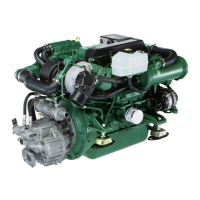80
Electrical system
Batteries
Battery terminology
Capacity
Capacity is measured in ampere-hours (Ah). The start-
er battery capacity (Ah) is usually stated as the bat-
tery’s 20 hour capacity, i.e. the battery can be dis-
charged at a constant current for 20 hours at a final
voltage of 1.75 V/cell. Ex: If a battery can produce 3
A for 20 hours, its capacity is 60 Ah. The capacity is
affected by temperature. The battery capacity is stat-
ed for +20°C (68°F). Cold considerably reduces a bat-
tery’s capacity to release its energy. The following ta-
ble shows the capacity differences at +20°C (68°F)
and -18°C (0°F).
Temperature +20°C (68°F) -18°C (0°F)
Capacity 100% 50%
70% 35%
40% 25%
Connecting batteries
If a boat has more than one battery, observe the fol-
lowing for the different connection methods:
Series connection:
Two 12 V batteries are connected in series so that the
system voltage in the boat is 24 V.
WARNING! Always check the boat’s system
voltage before connecting. A particular engine
type may be available for 12 V and 24 V config-
urations.
• The batteries must be similar (same capacity and
voltage).
• The batteries must be the same age since the
charge current required to produce a certain volt-
age changes with the age of the battery.
• There must not be unequal loading (equipment
should load both batteries - not just one). A small
load such as a radio connected across only one
battery can quickly destroy the batteries.
Electrical installation
General
The electrical installation has to be planned very care-
fully and carried out with the utmost care. Seek sim-
plicity when designing the electrical system.
The wires and connectors used in the installation have
to be of a type approved for marine use. The wires
should be routed in a protective sheath and clamped
properly.
Make sure that the leads are not installed too close to
heated parts of the engine or close to another source
of heat. The leads must not be subject to mechanical
wear. If necessary draw the leads through protective
tubing.
Attempt to get a minimum number of joints in the sys-
tem. Make sure that cables, and joints in particular,
are accessible for inspection and repair.
It is recommended to supply a wiring diagram of the
complete electrical system with the boat. This will
simplify fault tracing and installation of additional
equipment considerably.
NOTE! Make sure all components used are suitable
for the marine environment. Make sure that no joints
in the engine room end up deep down. All cable joints
should be located higher up than the alternator.

